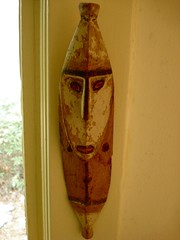In the early 20th century, African artifacts were being brought back to Paris museums in consequence of the expansion of the French empire into Africa, says Wikipedia.
The press was abuzz with exaggerated stories of cannibalism and exotic tales about the African kingdom of Dahomey. The mistreatment of Africans in the Belgian Congo was exposed in Joseph Conrad's popular book, Heart of Darkness.
It was natural in this climate of African interest that Picasso would look towards African artifacts as inspiration for some of his work; his interest was sparked by Henri Matisse who showed him a mask from the Dan region of Africa.[2]
In May or June 1907, Picasso experienced a "revelation" while viewing African art at the ethnographic museum at Palais du Trocadéro.[3] Picasso's discovery of African art influenced the style of his painting Les Demoiselles d'Avignon (begun in May 1907 and reworked in July of that year), especially in the treatment of the two figures on the right side of the composition.
Although Les Demoiselles is seen as the first Cubist work, Picasso continued to develop a style derived from African art before beginning the Analytic Cubism phase of his painting in 1910.
Other works of Picasso's African Period include the Bust of a Woman (1907, in the National Gallery, Prague); Mother and Child (Summer 1907, in the Musée Picasso, Paris); Nude with Raised Arms (1907, in the Thyssen-Bornemisza Museum, Lugano, Switzerland); and Three Woman (Summer 1908, in the Hermitage Museum, St. Petersburg).
Subscribe to:
Post Comments (Atom)





1 comment:
"African artifacts were being brought back to Paris"? This phrase, as it stands, could be misleading.
Post a Comment